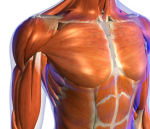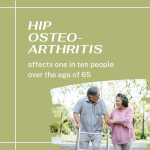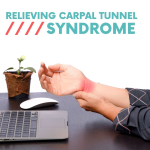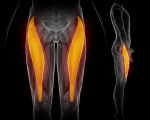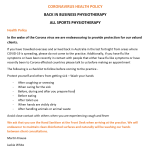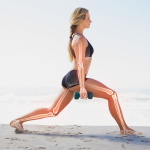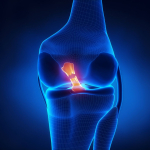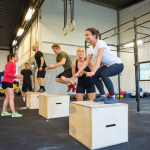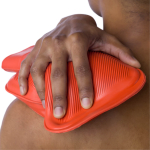-
Do I need a scan?Do I need a scan?
-
My friend / relative had the same low back problem, am I going to end up like them?
-
Are flexible muscles weak? Or are tight muscles strong?
-
I have been stretching my hamstrings for years, but I still can't touch my toes. Why not?
-
Basic similarities and differences between Physiotherapy, Chiropractic and Osteopathy
-
Preferred provider agreements
-
Cost
-
Location
-
Appointments
1. Do I need a scan / X-Ray ?
A scan, in it's self, will not improve anyone's condition. The purpose of a scan is to gain more information about the pathology. Sometimes this information may be irrelevant to the management of a patient's condition. For example, if you knocked your elbow on a door frame and suffered a bruise, which was already beginning to resolve, an ultrasound scan may show some minor soft tissue damage, but that was already obvious by the fact of the bruise, and the information gained from the scan has not helped nor changed the management of the bruise. Therefore, the main reason for getting a scan would be because there is concern that the presence of certain pathologies may lead to a change in the medical management. For example, sometimes a rolled ankle can be more than sprained ligaments, and may require surgey or immobilisation in a boot. If the therapists suspects this might be the case, then they will recommend or refer for a scan (probably an X-Ray) to check the integrity of the bones (especially the fibular and talar dome), because if there is no boney damage then the patient can be managed conservatively with taping, exercises, ultrasound, massage, joint mobilisations etc. However, if there is boney damage, for example, then it might be necessary for the ankle to be immobilised in a boot for six weeks, for example. This dramatically different medical management depends on the results of a scan, and it is therefore worth doing.
"a picture tells a thousand words" - not really!
However, scans have no predictive value to the presence or severity of pain. Thirty-three articles reporting imaging findings for 3110 asymptomatic individuals were investigated for pathology. The prevalence of disk degeneration in asymptomatic individuals increased from 37% of 20-year-old individuals to 96% of 80-year-old individuals. Disk bulge prevalence increased from 30% of those 20 years of age to 84% of those 80 years of age.Disk protrusion prevalence increased from 29% of those 20 years of age to 43% of those 80 years of age. The prevalence of annular fissure increased from 19% of those 20 years of age to 29% of those 80 years of age. (Brinjikji, W et al Spine Published November 27, 2014 as 10.3174/ajnr.A4173). Hence, imaging needs to be taken within the context of the entire clinical picture. frequently too much emphasis is placed on the imaging. Some people react to pathology on scanning as an affirmation of their problem and can either use it to gain clarity and become better or conversely become worse. Moreover, some people find imaging with inconclusive results as a 'panic moment' - "no one knows what is wrong".
Similarly, ultrasound imaging of the tendond has good predictive diagnostic and clinical reasoning when it comes to full tears. However, with partial tears it is a totally different 'ball game'. Sean Docking, a leading tendon researcher at la Trobe University, cited 7 authors who found pathological tendon chnages in 59% of asymptomatic individuals, whereas he found that 52% of asymptomatic elite AFL sportsmen had tendon pathology on imaging! Furthermore, symptomatic individuals who improved clinically to the point of resuming play, weren't shown to have improvements on imaging. Again, the clinical context and the clinical reasoning can in many instances prove to be the 'gold standard' not the imaging itself.
Shoulder supraspintatus tendon pathology, in the abscence of trauma, is known, in many instances, to be a disorder of immune-metabolic compromise. Imaging may show some changes in signal intensity but, unless it's a complete tear, it cannot reveal the intensity and severity of pain when taken outside of the clinical context. A thorough physical and subjective examination integrating all the clinical dimensions of the problem will have far greater value than any one single imaging modality taken out of context.
Yet, imaging still should be used in instances of progressive deterioration, suspected serious pathology requiring surgery and/or immediate medical intervention.
In summary, sometimes it is worthwhile getting a scan, because the information gained from that scan will determined the type of medical management that is employed. However, at other times, the scan may be unneccessary, because the information may be irrelevant or lead to an incorrect change in medical management, due to over-reporting of 'false positives'. You will be able to make this decision on the advice of your health care professional. On occasions it can actually be detrimental to have a scan, because some patients can become overly obsessed with the medical terms used to describe their scan results, which then can become the major focus for the clinician and the patient, rather than the more prefereable focus on their symptoms and functional abilities. For example, many people have lumbar buldging discs yet have no symptoms, yet sometimes when these patients have an MRI or CT scan, they can develop symptoms because they think they should have pain if the scan says so! Conversely, for some people the results of imaging can have a positive and reassuring affect. Therefore, it is very important to assess a clients attitude to scans before prescibing them so that the patient's expectations are managed appropriately, and not burdened by the additional, sometimes confusing, information supplied by a scan.
2. My friend / relative had the same low back problem, am I going to end up like them?
There are many variables between patients, and each patient should be treated differently depending on their individual presentation. There are many structures within the lumbar spine, including discs, joints, nerves, muscles, tendons, fascia, other connective tissues and much more. Even if it is the same structure, for example a lunbar discs, there are several different discs which can give somewhat different symtoms, and there are different pathologies that can occur to discs, such as a broadbased disc buldge, a focal hernia, a disc buldge causing nerve root impingement or formaninal narrowing etc. Then there is the obvious difference in the severity of the pathology and symptoms. Even if it is the same structure and the same pathology and with the same severity, which would be extremely unlikely, but possible there are other variables such as the muscular length and strength of the sorrounding and supporting structure, which plays a massive role in the patient's symptoms. Then there are the more obvious differences between patients, such as age, gender (which is important because of the anatomical differences between the male and female pelvis), history of previous low back pain, posture, weight, other medical issues (some chronic systemic conditions affect healing rates), fitness, previous medical treatments (for example past prolonged steroid use can affect healing rates, or past chemotherapy or radiotherapy can affect healing rates). Hopefully by now, you can see that every patient's presentation is as unique as people are different. It is impossible that one person's experience of low back pain will be the same as another's. There may be similarities, but it is much more likely that there will be more differences than similarities. Your physiotherapist will be able to assess most of these issues, and perscribe a treatment program to addesss these issues specific to each patient. For example some patients with low back pain may benefit from joint mobilisation and lumbar rotation stretches, whilst others may be better having a sacro-iliac brace and glut strengthening exercises. Sometimes the symtoms for these two very different conditions can appear superficially to be very similar, yet your physiotherapist will be able to differentiate and determine the most evidenced-based treatments that will get the best outcome for you.
3. Are flexible muscles weak? Or are tight muscles strong?
Muscle length and muscle strength are two separate variables. If a muscle is strong, it may be flexible or not. If a muscle it tight, it may be weak or strong. The two factors are pretty well independent.
In fact, a muscle can be strong in one position, but not in another. For example, the rotator cuff muscles might be fully functional and strong with the arm by the side, what we call the neutral position, but then if the arm is above the head, then those same muscles might not be as strong. This specific muscle testing in different positions is essential to perscribe the best possible exercsies for each patient indiidually. Another common example, is after a rolled ankle many patients are given ankle strengthening exercises where the patient moves the ankle sideways with a elastic band around the toes. This is a great strengthening exercise, but it is almost irrelevant to how the ankle normally functions, because in normal daily life the foot is on the ground and the patient is moving on top of a fixed foot (eg when walking or climbing stairs or jumping etc), however this exercise has the patient fixed and the foot moving freely. To properly rehabiliate an rolled ankle the exercises need to be progressed to doing some work with the foot fixed on the ground and the patient moving on top of the foot against some resistance. There are many creative and functional ways to do this, and your physiotherapist can show you how.
Alternatively, sometimes different parts of one muscle can be tight, but not the whole muscle, Sometimes this can be within a muscle where most of the fibres are running in different directions, such as the glut max, where the lowest muscle fibres are running at right angle to the most upper muscle fibres within the same muscle. Here it is obvious why one portion of the muscle can get tight, whilst another portion has maintained it's flexibility, because the different fibres have slightly different functions, and therefore can be affected differently by different activities, pathologies or demands placed on the muscles. Sometimes, there are muscles where the fibres are running in almost identical directions, such as the supraspinatus muscle, but along the length of the muscle there can be a tight band, whilst the rest of the muscle remains flexible. Sometimes patients called these tight bands, trigger points or knots or spasms or lumps or tightness. In each of the above cases different treatment techniques are required. Sometimes, for example, someone might be stretching their gluts, but to no good effect, but by simply making a small adjustment to the angle they are stretching or the position they are stretching in, then you can target different muscle fibres and gain a more effective stretch, and your physiotherapist will be able to show you how to do this.
4. I have been stretching my hamstrings for years, but I still can't touch my toes. Why not?
There could be many different reasons for this, and it is most likely to be a combination of these reasons. Firstly, it may simply be because your stretching technique is insufficient to poduce the results you are after, with the most common mistakes being dossage issues, such as not holding the stretch for long enough or not performing the stretch frequently enough. Another common mistake is the stretching technique it's self, where the patient may not even be getting their hamstrings on stretch, despite feeling a lot of 'pulling' in the posterior leg. It may be that the patient is actually stretching their sciatic nerve, rather than their hamstring muscle, and sometimes this can be very difficult to differentiate between, but your physiotherapist will be able to differentiate out which is happening and what action should be taken to address this isssue. Secondly, it may not be the hamstring muscle which is limiting your flexibility, for example the gastrocnemius muscle might be restricting the amount of knee extension, or more likely the gluts might be limited the amount of hip flexion you can get. Alternatively, it might not be a muscle at all, and perhaps the lumbar or thoracic spine is stiff and restricting how far you can bend forwards. However, the most likely reason for patients to complain of posterior thigh tightness, which cannot be relieved by hamstring stretching is actually because of neural tension. The sciatic nerve runs alongside of the hamstring muscle, and some portions of the sciatic nerve actually insert into the hamstring muscle. It is highly unlikely that the sciatic nerve can change it's length in a fully grown adult, but it is definitely possible for the nerve to improve it's mobility, and therefore change your flexibility. The way to do this is with neural mobilisation exercises, and again, your physiotherapist can advise you on the best of many different ways to do this, that is specific to your functional limitations. This is particularly important for those people who require flexible hamstrings, such as AFL footballers, rowers and ballet dancers.
5. Basic similarities and differences between Physiotherapy, Chiropractic and Osteopathy
Therapy for the back or spine comes in various forms, shapes and sizes with many different advocates giving advice deciding between a Physiotherapy, Osteopathy, or Chiropractor. Frequently as a physiotherapist we are asked what osteopaths and chiropractors do. As all three hold important differences related to how practitioners devise treatment plans it may be worth summarising the basic similarities and differences.
Chiropractors and Osteopaths can be considered similar in the sense that both have a primary treatment strategy involving joint manipulations. However, there are some differences in their levels of training and the core ideas that revolve around how diagnosis is made for each individual patient. Chiropractors are influenced mainly by the body’s nervous system, while Osteopaths focus on organs, muscles and connective tissues. The chiropractic profession evolved out of the east coast of the USA, whereas osteopathy continued to be developed in the UK.
Both Chiropractors and Osteopaths have a unique perspective on how the spine performs and are known for successfully treating back issues. Chiropractors are generally licenced to use X-rays for one’s initial consultation and will likely start with an assessment, then massage by a masseur and finally an adjustment by a manipulation of the spine as a part of treatment. They aim is to correct the peripheral nervous system through the correction of spinal alignment which allows the improvement in how one moves and responds to sensations. Much like Osteopathy and Physiotherapy, a Chiropractic doctor will remind patients of how important nutrition and exercise is for keeping the back healthy and to reduce pain that may be problematic in the future. Chiropractic doctors are known as the least holistic of the three, but many have been known to offer lifestyle suggestions and have taken on naturopathic qualifications.
A Physiotherapist is likely to start with how one may heal back injuries with modifications to an unhealthy lifestyle. Physiotherapists restore joint movement and help patients with recovery following surgery with fewer amounts of hands on therapy than that of a Chiropractor. Emphasis on exercise therapy is likely with a Physiotherapist as their main focus is on self managed movement strategies to prevent recurrences and chronicity of the condition. Some APA titled musculoskeletal physiotherapists manipulate. However, generally, the Physiotherapeutic process makes use of manual therapy in the form of joint mobilisations (derived from osteopathic techniques) as well as massage, dry needling, muscle energy techniques, taping and motor control strategies educating the client on how the muscles and joints work together. Moreover, in the presence of disc pathology and nerve irritation and compression, the use of spinal manipulation is contra-indicated in the physiotherapy world. Additionally, many physiotherapists don’t manipulate the upper cervical spine, due to the inherent danger to the vertebral artery, which if damaged could result in stroke or even death.
The aim across all professions is to reduce muscle spasms, which reduces joint and disc compression, however the physiotherapist aims to restore the activity in the muscles that act as slings across the joint. Some of these muscle slings are considered mobilizers whilst others are considered stabilisers. Another consideration in physiotherapy is whether the client falls into a category of ‘stiffy’ (hypomobility) or ‘floppy’ (hypermobility). Floppies tend to have ballistic muscle functionality, whereas stiffies tend to be slow twitch endurance type characters. It’s typical for a Physiotherapist to help the patient heal by focusing on the balance of the muscles, core strength, the patients’ strength and overall stability. Physiotherapy has a holistic viewpoint and uses a variety of drug free techniques to aid in the relief and prevention of chronic pain.
Osteopathy is similar to Physiotherapy in the way that both practitioners have been considered to take a gentler approach than that of a traditional Chiropractor. Osteopathy places a lot of emphasis on internal organ function. Some spinal adjustments may be used during treatment, but only with the most careful and precise movements of one’s joints. Osteopaths have a reputation for treating back, neck and shoulder pain and often utilize a range of alternative healing techniques. Osteopaths have a belief that the body has natural healing abilities and it’s vital for one to live a lifestyle that promotes optimum health. Osteopathy encourages treatment in a holistic manner for the client to return to proper function. The Osteopath seeks to provide symptomatic relief, but also addresses whatever the underlying cause of pain may be. Osteopaths use gentle and effective techniques such as stretching, joint mobilisation, massage and manipulation to skillfully address the significant biomechanical dysfunctions in your body that relate to your complaint.
Chiropractors, Physiotherapists, and Osteopaths all believe that the integrity of the spine is important for optimal health, with the main differences, of the three, lying in the reasoning and professional knowledge which defines the specific style of treatment for each and every patient. Finally, both chiropractors and osteopaths treat neonates and very young children with spinal adjustments whereas physiotherapists generally do not.
6. Preferred provider agreements
BUPA and its subsidiaries which include HBA, Mutual Community and MBF have for a long time referred to practitioners who have agreed to their fee structure of remuneration as 'preferred providers'. This is misleading, as the term appears to confer some special skills, knowledge, expertise to these 'preferred providers' which in most cases isn't so. In fact, with practitioners agreeing to a lesser form of remuneration they are not only undermining the value of their treatment, they are also potentially involved in price fixing and collusion, which probably could be seen as an anti-competitive act which, may come under the auspices of the ACCC. Each individual practice has different operating costs and should be allowed to charge accordingly. Additionally, the health fund rebate is based on 20 minute consultations, which, in a practice like ours, with approx 40 minute consults, makes the entering into an agreement, an impossible one. Never-the-less, it should be noted, just because we aren't 'preferred providers' doesn't mean that you won't get a rebate on our services. In fact, these health funds rebate anywhere from $22.- up to $112.- for our services. You should contact your health fund directly to ascertain your precise level of cover.
Updated : 21 December 2019

OUR PHYSIOTHERAPISTS HAVE HIGHLY REGARDED POST-GRADUATE QUALIFICATIONS
AND WORK AT THE CUTTING EDGE OF MUSCULOSKELETAL SERVICES.
Corner of Mount and Walker streets. Suite 201, 107, Walker Street,
North Sydney 2060. Phone: 9922 6806
Email : This email address is being protected from spambots. You need JavaScript enabled to view it.
5 minutes walk from North Sydney station at the heart of the CBD.
Treatment, Prevention, Education
For On Line Appointment availability and to make a booking contact us using 1stAvailable:
N.B. In order to use online booking you must register your correct details and provide a legitimate email address and mobile phone number.


















